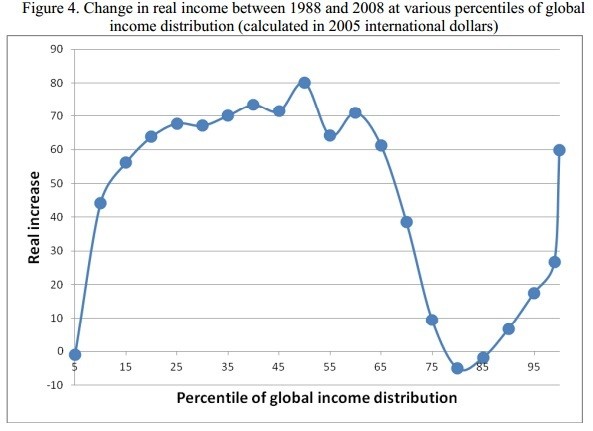
The “Elephant” Chart Explains Why Many Hate Globalization
Although globalization has greatly benefited many people around the world, it hurt a lot one particular class of people.
The “elephant” chart below shows who benefits and who is hurt by globalization.
Globalization greatly increased income of:
(1) moderately poor people in moderately poor countries (those between 15th and 60th percentiles on the global income distribution, or those who made from about $150 per month to $750 per month);
(2) very rich people (top 3%, or those who make more than $10,000 per month, and especially those who make $50,000 per month or more).
At the same time, globalization did not benefit
(1) the poorest 10% (those who make less than $150 per month) and
(2) actually hurt the working class in developed countries, those between the 75th and 85th percentile (those who make between $1,500 and $3,500 in E.U., U.S.A., and other “developed” regions.
In other words, globalization improved income of poor people in Asia and Latin America who now have jobs at factories making goods for export, jobs in call centers, IT firms and the like.
Globalization also greatly improved income of the well-ff people, such as business owners, world-class experts and consultants, specialists who do the intellectual work for companies that benefit from globalization.
However, it hurt the former factory workers in the “developed” countries who now face competition from low-wage countries.
Why do we hear so much negativism about globalization despite the fact that the vast majority (about 80% of the world population) benefit from it? Because people tend to be very vocal about their losses and work very hard to prevent such losses. However, people tend to be less excited about their gains.
It’s easy to imagine Chrysler factory workers protesting against lay-offs or low wages.
It’s not easy to imagine Apple employees celebrating in the streets their big bonuses due to great global popularity of their assembled-in-China iPhones and iMacs.
Full story by World Economic Forum: https://goo.gl/605Cr8

